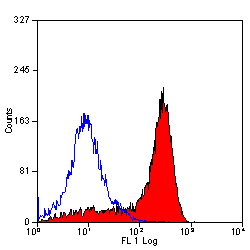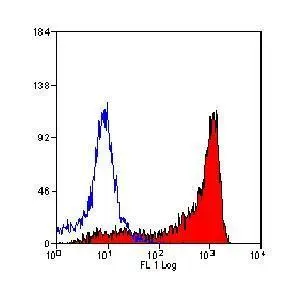
Staining of rat peritoneal macrophages with Mouse anti Rat CD11b (GTX76060)
CD11b antibody [OX-42] (Biotin)
GTX53827
ApplicationsFlow Cytometry, ImmunoHistoChemistry, ImmunoHistoChemistry Frozen
Product group Antibodies
ReactivityRat
TargetItgam
Overview
- SupplierGeneTex
- Product NameCD11b antibody [OX-42] (Biotin)
- Delivery Days Customer9
- Antibody SpecificityRat CD11b/c
- Application Supplier NoteThis antibody has been used in Immunohistochemistry (Frozen sections), Flow Cytometry / FACS. Recomended dilutions - FACS: Use neat - 1/10, or 10microl of the suggested working dilution to label 106 cells in 100microl. IHC-Fr: Use at an assay dependent dilution. Note: samples need to be PLP (periodate-lysine-paraformaldehyde) fixed. Not yet tested in other applications. Optimal dilutions/concentrations should be determined by the end user.
- ApplicationsFlow Cytometry, ImmunoHistoChemistry, ImmunoHistoChemistry Frozen
- CertificationResearch Use Only
- ClonalityMonoclonal
- Clone IDOX-42
- Concentration0.1 mg/ml
- ConjugateBiotin
- Gene ID25021
- Target nameItgam
- Target descriptionintegrin subunit alpha M
- Target synonymsCd11b; integrin alpha-M; integrin, alpha M
- HostMouse
- IsotypeIgG2a
- Scientific DescriptionCD11b is implicated in various adhesive interactions of monocytes, macrophages and granulocytes as well as in mediating the uptake of complement coated particles. It is identical to CR3, the receptor for the iC3b fragment of the third complement component. It probably recognizes the RGD peptide in C3b. CD11b is also a receptor for fibrinogen, factor X and ICAM1. It recognizes P1 and P2 peptides of fibrinogen gamma chain. The Mac1 CD11b antigen is present on macrophages, granulocytes, natural killer cells, blood monocytes. CD11b is expressed on 8% spleen cells, 44% bone marrow cells and less than 1% of thymocytes and is commonly used as a microglial marker in nervous tissue.GTX53827 recognises CD11b expressed on most macrophages, including resident and activated peritoneal macrophages, Kupffer cells, around 35% of alveolar macrophages, dendritic cells, granulocytes and microglial cells in the brain.
- ReactivityRat
- Storage Instruction-20°C or -80°C,2°C to 8°C
- UNSPSC12352203
References
- Bone marrow mesenchymal stem cell-derived exosomes shuttling miR-150-5p alleviates mechanical allodynia in rats by targeting NOTCH2 in microglia.Read more
- Pro-Inflammatory Effect of Gliadins and Glutenins Extracted from Different Wheat Cultivars on an In Vitro 3D Intestinal Epithelium Model. Truzzi F et al., 2020 Dec 26, Int J Mol SciRead more
- Investigating The Alterations of Oxidative Stress Status, Antioxidant Defense Mechanisms, MAP Kinase and Mitochondrial Apoptotic Pathway in Adipose-Derived Mesenchymal Stem Cells from STZ Diabetic Rats. Aminzadeh A et al., 2020 Jul, Cell JRead more
- G-protein-coupled estrogen receptor activation upregulates interleukin-1 receptor antagonist in the hippocampus after global cerebral ischemia: implications for neuronal self-defense. Bai N et al., 2020 Feb 1, J NeuroinflammationRead more
- Microglia-Derived Adiposomes are Potential Targets for the Treatment of Ischemic Stroke. Lin CH et al., 2019 Jul, Cell Mol NeurobiolRead more
- The P2X7 Receptor, Cathepsin S and Fractalkine in the Trigeminal Subnucleus Caudalis Signal Persistent Hypernociception in Temporomandibular Rat Joints. Bonfante R et al., 2018 Nov 1, NeuroscienceRead more
- Molecular Mechanisms Responsible for Neuron-Derived Conditioned Medium (NCM)-Mediated Protection of Ischemic Brain. Lin CH et al., 2016, PLoS OneRead more
- Transplantation of mesenchymal stem cells promotes an alternative pathway of macrophage activation and functional recovery after spinal cord injury. Nakajima H et al., 2012 May 20, J NeurotraumaRead more
- IL-1beta in the trigeminal subnucleus caudalis contributes to extra-territorial allodynia/hyperalgesia following a trigeminal nerve injury. Takahashi K et al., 2011 May, Eur J PainRead more
- Lactosyl derivatives function in a rat model of severe burn shock by acting as antagonists against CD11b of integrin on leukocytes. Zhao Z et al., 2009 Feb, Glycoconj JRead more

